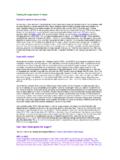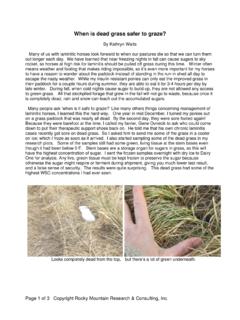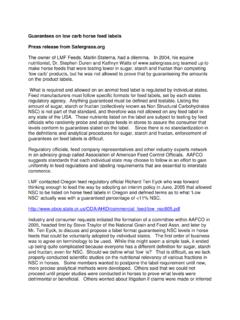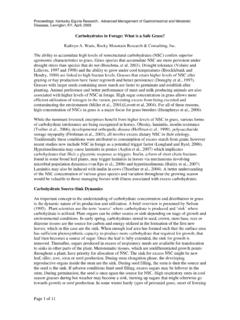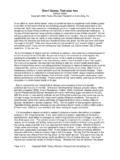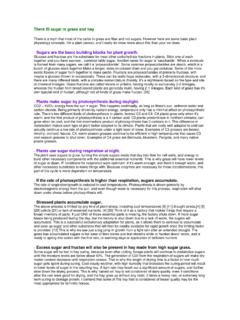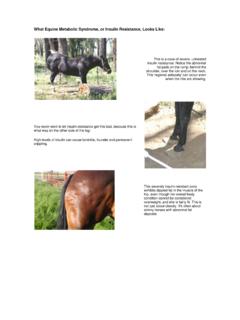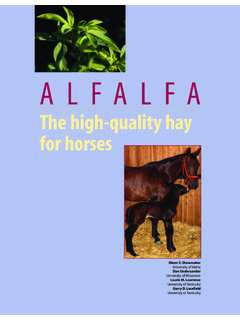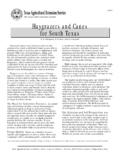Transcription of Does Sugar Concentration Determine Hay …
1 Does Sugar Concentration Determine Hay Preference by horses ? Kathryn Watts, Rocky Mtn. Research & Consulting, Inc. Horse owners often suggest that horses select the highest Sugar hays as their favorite forage. This premise invites study into whether samples of various hays can be presented to a horse, and the least palatable hay will emerge as the one lowest in Sugar . Owners of horses with abnormal glucose metabolism must rely on low Sugar hay for the bulk of their horse s diet.
2 This requires testing of hay before purchase to assure its suitability. Not many hay producers have appropriate tests available, putting the burden of testing onto horse owners. Purchasers may not have the proper equipment and sampling hay without a hay probe may not provide accurate results. Delay in getting hay test results complicates making informed decisions while the hay is still available for purchase. Previous studies looking at the correlation between Sugar content and palatability to horses show conflicting results.
3 When the only difference between choices of an alfalfa/wheatgrass mix was 12 hours difference in time of cutting, horses preferred the hay cut in evening that had higher Sugar Concentration (MacKay et al). Yearlings preferred alfalfa over bromegrass and Bermuda in spite of being the lowest choice in Non Structural Carbohydrates (NSC= Sugar , starch and fructan)(LaCasha et al). In Australia, researchers also found a negative correlation to Water Soluble Carbohydrate (WSC= Sugar and fructan) content when offering different selections of oat and alfalfa hays to horses (Pain and Revell).
4 Those authors suggested that horses chose to avoid consuming too much soluble carbohydrate thereby reducing the risks for laminitis. These authors never studied the eating preferences of laminitic horses , and most anecdotal evidence confirms that horses are quite willing to eat more soluble carbohydrates than is good for them. When horse owners are shopping for hay they often have several selections to choose from that may vary in species as well as having wide variations in both quality and nutritive characteristics.
5 This study was conducted to see if horses pick out hays with higher NSC content when given a wider variety of choices than in previous studies. The hay that horses are accustomed to may affect preference (Pain and Revell) (LaCasha et al), therefore data from the two herds in this study was also analyzed separately to detect any differences. Procedure: Six different bales of hay were probed and tested for Crude protein, WSC, ESC, starch, ADF, NDF, DE and TDN. Six ounces of each hay was weighed and placed in identical plastic trays, and placed in a line before a single, loose horse.
6 Thirteen different horses were allowed access to the hay. Video was taken to review eating behavior. Some horses just ate what was in front of them, so hays were shuffled for the first 5 minutes, until the horse started seeking out particular hays, even when moved to a different place. After 15 minutes, trays were removed and remaining hay weighed. Palatability ranking was based on hays that had the least amount remaining (averaged across all horses ), and when everything in a tray was consumed, the order at which they were cleaned up.
7 The most palatable was ranked 6 and the least palatable was ranked 1. Page 1 of 5 Copyright 2011 Rocky Mtn Research & Consulting, Inc. Test subjects ranged from 16 H warmbloods and QH crosses to h Welsh and New Forrest ponies on 2 different farms. Tests were conducted before mid-day feeding to eliminate satiety as a factor. The amount of hay eaten in 15 minutes out of a total 36 oz offered ranged from oz by the h Welsh pony to 31 oz by a 14 H New Forrest/WelshX pony.
8 Both of these ponies ate very fast, but the smaller pony had a very small muzzle and was limited to bite size compared to the larger horses . Animals came from 2 different farms. At farm one, Hay # 4 and 5 were both fed. At the second farm, all the hays offered were novel, but similar to hay #4. When given a choice of 6 hays, horses would pass over some trays without tasting. Other times they might taste a hay, then move on to another tray. Most often, when they found a hay they liked, they would eat it all before trying another tray, even following that tray if moved.
9 Generally, 2 hays were completely eaten, 2 were partially eaten and 2 were mostly ignored in the time allotted. Early in the study, it was apparent that something other than NSC content was determining which hays the horses ate first. Zip lock bags of each hay were presented to 4 different horse owners with instructions to guess which hays their horses would prefer, and why. The hays the owners chose as most palatable were fragrant; smelling like fresh mown hay.
10 The 3 other hays were described as smelling blah , or having no smell , but this trait could not be quantified for analysis. None smelled bad or moldy. All six were pale green in color, loose and put up very dry. Moisture content ranged from to CP NDFH orse DE WSCstarchESCWSC+starch palatability rank 1 Meadow Foxtail 4 2 Harmon 2008 3rd 6 6 Strom 2008 3rd 5 4 Strom 2008 1st 9 3 5 Strom 2008 2nd 7 1 3 Blue Grama 2007 2 Page 2 of 5 Copyright 2011 Rocky Mtn Research & Consulting, Inc.
